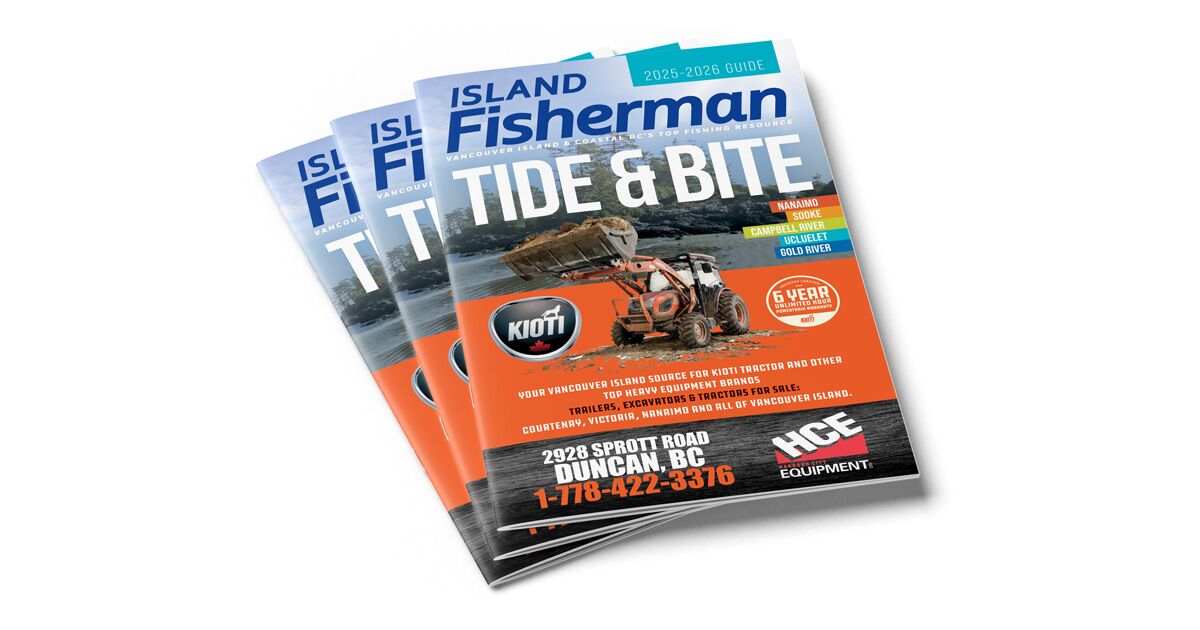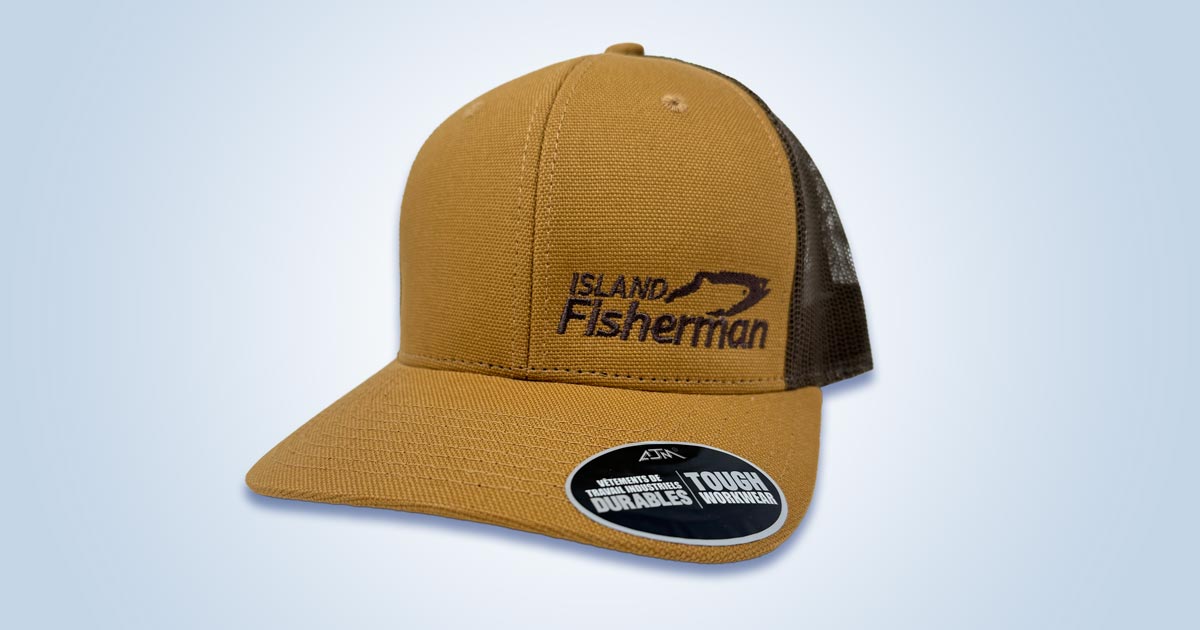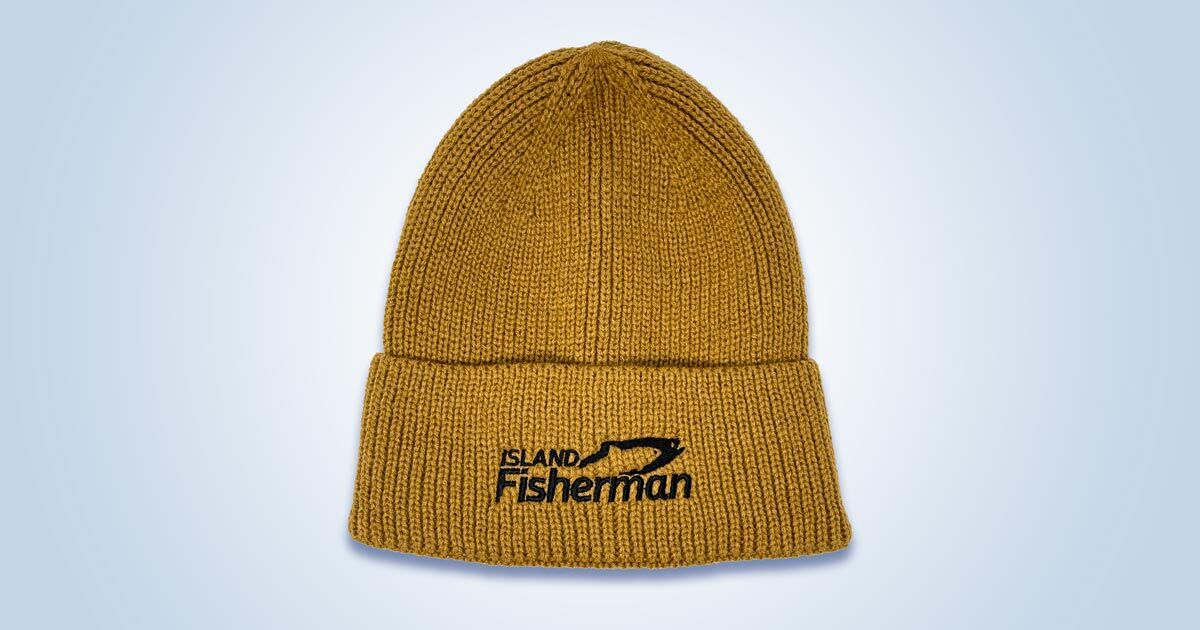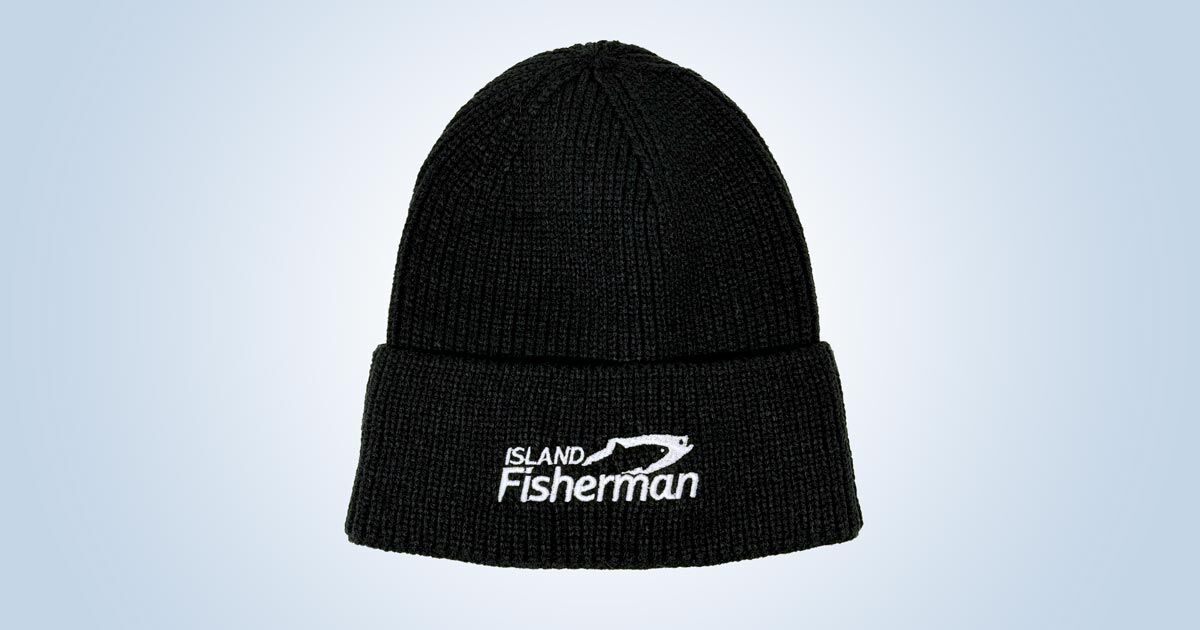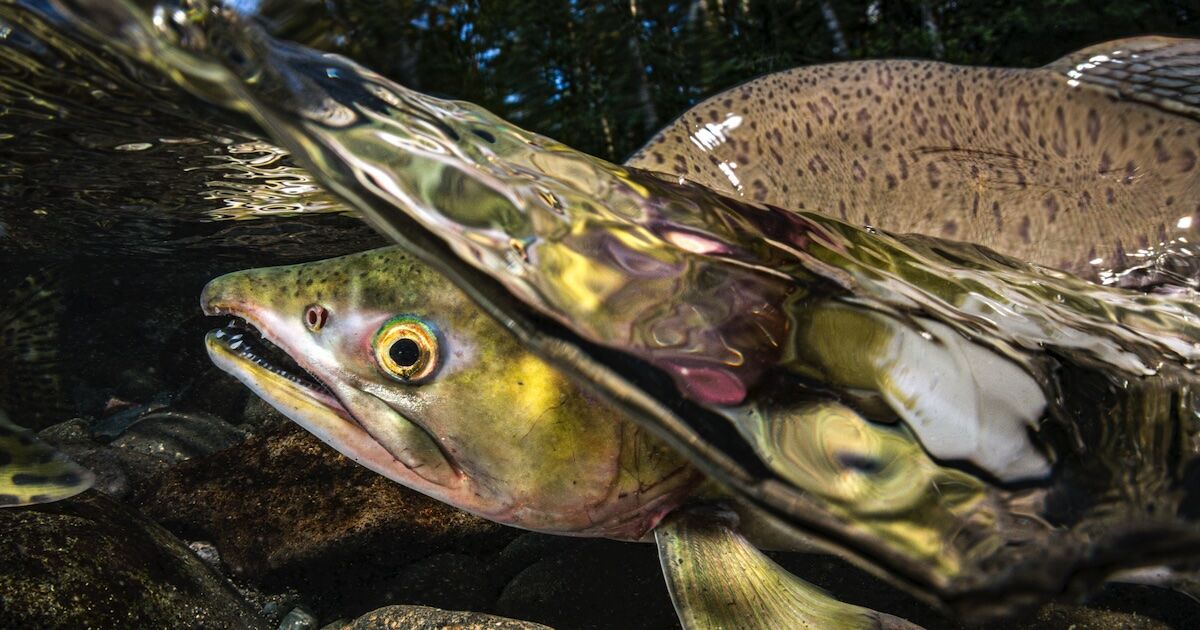
Male “humpy” pink salmon in the Quinsam River near Campbell River, BC (Photo: Eiko Jones Photography)
Scientific name: Oncorhynchus gorbuscha
Kingdom: Animalia
Phylum: Chordata
Class: Actinopterygii
Order: Salmoniformes
Family: Salmonidae
Genus: Oncorhynchus
Species: gorbuscha
If you fish the Pacific waters around Vancouver Island, you’ve likely already heard the buzz—2025 is forecast to bring one of the largest pink salmon runs in recorded history. While Chinook and sockeye often get the spotlight, this year, it’s the pink salmon’s time to shine. Let’s take a closer look at what makes these small but mighty salmon so unique. (Note: the July 2025 issue of Island Fisherman magazine is a deep dive into the historic 2025 return.)
Meet the Pink Salmon
Pink salmon (Oncorhynchus gorbuscha) are the smallest of the Pacific salmon, but they’re also the most abundant, making them a familiar sight in the waters around Vancouver Island. These little powerhouses usually weigh between 3 and 5 lbs and grow to about 20 to 25″ long. When the males get ready to spawn, they develop a big hump on their backs, which is why they’re often called “humpies.” However, the last record we found was 15.40 lbs by Adam Stewart in the Stillaguamish River, Snohomish County, October 11, 2007.
Adam Stewart proudly displays his record-breaking catch. Click the image to read the Arlington Times article.
Pink salmon grow fast and head out to sea almost as soon as they hatch, unlike other salmon that might stick around in freshwater for a year or more. Once in the ocean, pinks school in surface waters, feeding on zooplankton, krill, and larval fish. Their ocean journey is short but intense, and just two years later, they’re back in the rivers, ready to complete their life cycle.
Pink salmon in its ocean phase. Image courtesy of the Ministry of Forests, Wildlife and Parks, Québec
What sets pink salmon apart is their distinctive appearance and the transformations they undergo. Young pinks are completely silver, with no dark bars or spots like those seen on coho or Chinook. In the ocean, adults are bright silver on the sides, with a greenish-blue or steel-blue back and tiny, smooth scales that give them a sleek, streamlined look.
Pink salmon in its spawning phase. Image courtesy of the Ministry of Forests, Wildlife and Parks, Québec
When it’s time to spawn, pink salmon put on a show. They develop large black spots on their backs and tails, something you won’t see on other Pacific salmon. Males turn dark along the back, grow hooked jaws called a kype, and get that big, showy hump. Females don’t have the hump, but they turn olive green with bars or patches in lavender or dark gold, and their bellies stay bright white. These changes help them blend into their river habitat during this crucial stage.
Where Pink Salmon Live and Migrate
Pink salmon have adapted to a wide range of spawning habitats, making them one of the most flexible of the Pacific salmon. Around Vancouver Island, they return to rivers like the Goldstream, Quinsam, Big Qualicum, and Campbell River, as well as many smaller creeks. Unlike sockeye, which require lakes for part of their juvenile development, or Chinook, which travel far upstream, pink salmon typically choose lower river systems closer to the ocean. They often spawn in shallow, gravel-bottomed stretches with moderate flow—habitats that are accessible and provide the oxygen-rich water their eggs need.
Pink salmon on Vancouver Island (photo: Eiko Jones Photography)
This adaptability is one reason pinks are so resilient. While other salmon species might struggle in fragmented or altered waterways, pink salmon can make use of small coastal streams, side channels, and even ditches. This flexibility helps them thrive in areas where habitat has been impacted by development, forestry, or climate change. Read our article on ”How the Quinsam River Hatchery Saved the Nanaimo River Pink Salmon”.
The cycle continues after they spawn and die. After they spawn and die, pink salmon carcasses decompose and release essential nutrients like nitrogen and phosphorus into the river, feeding everything from aquatic insects to young salmon. These nutrients support a whole web of life, including bears, eagles, and other wildlife that rely on salmon as a seasonal food source.
Pink Salmon at the end of its mission. Having successfully spawned, its carcass returns nutrients to the river and earth. (photo: Eiko Jones Photography)
Geographically, pink salmon have an impressive range. They’re found from the Arctic coast of Alaska and northern Canada down to Puget Sound in Washington State, and across to Russia and North Korea. In North America, they’re less common south of Puget Sound, but north of there, they’re a key part of many river systems.
When it comes time to spawn, pink salmon typically don’t travel far upstream. They generally spawn within 45 kms of a river’s mouth, sticking to coastal rivers and streams that connect them directly to the ocean they’ve called home for the last two years. Unlike other Pacific salmon that migrate hundreds of kilometres, pinks keep it close to home—part of what makes them such a reliable presence in these coastal waters.
Spawning of Pink Salmon, Oncorhynchus gorbuscha. The male and female salmon come together and release the eggs and milt directly down into the gravel of the nest. Other males join in to increase genetic diversity. (photo: Eiko Jones Photography)
Why Do They Run on Odd Years?
Pink salmon are known for their strict two-year life cycle; from egg to ocean to spawning adult, pinks complete their entire life’s journey in just two years and stick to this precise schedule without fail.
Because pinks return only every second year, there’s no overlap between generations—odd-year and even-year pink salmon are two genetically distinct lineages. While you will see pinks returning every year (factors like hatchery programs contribute), keep this in mind. This genetic separation is a smart survival strategy: with no competition from overlapping generations, pinks avoid fighting for resources and reduce the risk of disease spreading within their runs. For anglers, this means every other year—like 2025—brings a sudden and dramatic surge in pink numbers, creating a true “boom year” that’s a thrill to experience.
Interestingly, this odd-year pattern isn’t universal across the Pacific. Further north in BC and western Alaska, there are even-year pink salmon runs that can be just as strong, or even stronger, than odd-year runs. In Puget Sound rivers south of the border, some pink salmon also run on even-year cycles.
The explanation lies in the region’s geological history. After the last Ice Age, retreating glaciers reshaped the river systems across the Pacific Rim. As pink salmon recolonized these rivers, some populations settled into odd-year cycles while others established even-year runs. Because pinks live only two years, these cycles quickly became isolated from one another. Today, genetic studies confirm that odd- and even-year pink salmon are as distinct as cousins, even within the same watershed.
A Few More Interesting Pink Salmon Facts
Pink salmon might be the smallest of the Pacific salmon, but they’re full of surprises. One of the most fascinating things about pink salmon is how they change their appearance when it’s time to spawn. At the same time, as they head for the rivers, they stop eating altogether—sometimes going without food for up to six months, putting every last bit of energy into the next generation.
Don’t let their small size fool you. Pink salmon can leap up to two metres—about the height of some Olympic athletes—to get past waterfalls and other obstacles on their journey home.
Their flesh is the lightest in colour—a soft, pale pink that’s mild and delicately flavoured. While they might not have the deep red of sockeye or the rich oiliness of Chinook, pink salmon still bring a gentle, slightly sweet taste to the table. It’s perfect for light grilling, baking, or even enjoying fresh from the smoker.
Here’s something you might not expect: pink salmon and Chinook salmon have the exact same number of scales despite being at completely different ends of the size chart, with Chinook growing up to a massive 50 kgs.
Decklan Finlay catching pink salmon on the fly from Campbell River
2025: A Banner Year for Pink Salmon
This year’s pink salmon run is forecast to be the biggest we’ve seen, and it’s a strong indicator of the health of our rivers and coastal waters and the Salish Sea. Healthy runs like this one show that our local ecosystems are in good shape to support pink salmon and the countless other creatures that depend on them. For anglers, it means plenty of opportunities to get out on the water and take part in a fishing season that’s shaping up to be one for the record books. Ready for tips on how to catch pink salmon?
Don’t miss the July 2025 issue of Island Fisherman where we dive in to all the details about our friends, the pink salmon. This is an issue to keep with stunning photography and deep dive articles found nowhere else. If you already missed it, click here to order the back issue in PDF.
Visit the Store
$34.99
$34.99
Featured Catch
Joel Unickow halibut (Photo: Rob Frawley Lucky Strike Sportfishing Tofino)

